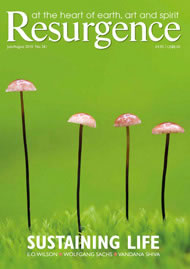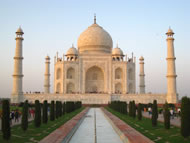It would seem that most philosophers, aestheticians, art historians and even scientists and mathematicians think that beauty is invariant. For the many amongst us who have trouble recognising and appreciating those things they have declared beautiful, and the many who don’t wish to be bothered with an engagement with beauty, the experts generally recommend better education and cultivating refinement and sensitivity.
Education, refinement and increased sensitivity are all undoubtedly excellent ideas, but I wonder if the prevalent theories of beauty are not part of the reason why so many people find ‘beauty’ too elusive, elitist and irrelevant to their everyday concerns – other than the hugely popular ‘make-up’ kind conjured up by cosmetics, in salons and parlours.
The search for invariance, or constant and absolute truths, has been going on for a very long time in most cultures. Religions are replete with this urge and it has now found a home in the sciences. Physicists, biologists and mathematicians all seek to discover invariant truths: their theories and theorems are attempts to understand and explain the stuff of the Universe and unravel the magic of Life in it. Curiously, in mathematics, a root language for the sciences, invariance is usually referred to as symmetry.
This search for symmetry involves looking beneath superficial differences that camouflage similarities to find a more substantive meaning – or truths, which define what scientists believe are the properties of Nature that are invariant or conserved, no matter what. Even Einstein, whose theory of relativity is popularly and mistakenly associated with the idea that everything is relative, was actually attempting quite the opposite. He was searching for, as K.C. Cole evocatively describes in her book The Universe and the Teacup: The Mathematics of Truth and Beauty, ‘the unvarying deep truths that do not depend on fickle appearances … the hidden scaffolding that holds the many-faceted house of nature up’.
Now we all know that many of the things we admire as beautiful are symmetrical: natural symmetries like snowflakes and snail shells, and human-made symmetries like the Pyramids and the Taj Mahal.
This, according to the scientists and mathematicians, particularly those with a musical or artistic bent, is because of a connection between what we admire for aesthetic reasons and those very things that steer them towards a deeper quantitative understanding of Nature in all its forms. They claim that these are the same symmetries that appeal to the senses in natural forms like snowflakes and galaxies and to what is beautiful in art and music.
“To understand nature, that is to understand its rules, is equivalent to understanding its symmetries.”
– Lawrence Krauss, physicist
“What’s beautiful in science is the same that’s beautiful in Beethoven. There’s a fog of events and suddenly you see a connection. It expresses a complex of human concerns that goes deeply to you, that connects things that were always in you that were never put together before.” – Victor Weisskopf, physicist
“At the fundamental level nature, for whatever reason, prefers beauty.”
– David Gross, physicist, Director of the Institute of Theoretical Physics at UC, Santa Barbara
And this following quote from Edward Rothstein, mathematician and musician, writing about the emotional responses we ‘feel’ in the presence of beauty – in maths or music:
“What we ‘feel’ in such moments is the analogy of the part and the whole, object and other object, relation and relation … This notion of symmetry is close to what we call, in other contexts, harmony.”
It almost seems that science and mathematics are confirming the old aphorism Truth, Beauty and Goodness by explaining that beauty is symmetry, which is invariant and true – no matter what – and this I suppose makes it eternal as well. The new scientific formulation might read Invariance, Symmetry and Beauty, as science is still a little awkward about Goodness!
So there we are then: beauty is invariant.
Yet, for the sake of beauty, I think we can’t stop here, and here’s why: Let’s consider snowflakes. Strictly speaking, they are not invariant – apparently, despite their enormous numbers, they are rarely, if ever, identical. They look similar, but are always different, each one of them. And, as a practical matter, their beauty comes alive best in photographs with some magnification. To the eye, and particularly in places like New Hampshire in the cold grip of February, they can, in the millions, appear quite miserable.
When, seated comfortably on a sofa, we do see them at their beautiful best, in a high-quality book with well-reproduced photographs, we may wish to enquire what it is about them that makes people invariably feel and realise their undeniable beauty.
Is it the obvious symmetry in their form? But what then about the veined leaf of the Bodhi tree or the perfect symmetry of the Taj Mahal? They are very different forms, with different symmetries. This makes it clear that beauty is not about any one particular, invariant form.
Does it, then, have something to do with the relational qualities of coherence, being just so, of proportion and harmony and rhythm, that these forms embody? Or are imbued with? Even exude? So that whenever there is a high level of relational excellence – in form, or sound, or even in human beings – there is beauty.
Another fact we can’t ignore is that what people find beautiful has changed over time. It seems somehow difficult to explain this as a decline in aesthetic acculturation. There is a view that because some of us can’t relate to some older piece of music or art, however great it may be considered to be by art historians or aestheticians, we are somehow deficient – less sensitive or less capable of appreciating beauty. This seems elitist, and many of us have become tired of being told what is invariantly beautiful: what we should like if we had any taste.
We now live in times of greater awareness of the diversity of cultures. We know that there are just too many people who like things other than what the experts want us to believe are the objects or sounds of invariant beauty. What we surely need are fewer people who have cultural inferiority complexes and a much wider and more embracing appreciation of the enormous beauty that is and can be in our everyday lives. I do think it will be a good thing if more people feel ‘beauty-enabled’.
Though people may find the experience of beauty in different things, what they seem to experience appears to be quite similar across time and cultures. When asked what they feel when they experience beauty, they say in Japanese and Sanskrit, Mandarin and French, English Olde and new: pleasure, delight, wellbeing, gladness, grace, elegance, timelessness, peace, excitement, harmony, wellness, joy, spaciousness, connectedness, wholeness…
Perhaps there is a hierarchy in beauty. Is it possible that beauty exists at many levels – some variant and others that are invariant? That there is beauty at the level of appearances – what we can perceive through our senses – and there is beauty at the deep structural levels which is not visible or engageable by our senses? We may have to go deeper than the visible or audible forms to understand the invariance of beauty. This might allow us to accommodate the diversity of stimuli that create the beauty experience, and yet keep the space open for a deeper, more profound and invariant beauty.
What, then, are the properties of deep beauty – as seen in the arts, mathematics, sciences?
It has become obvious that if there is to be any shared and invariant beauty it is much more likely to be Einsteinian than Newtonian. Beauty is contextual in space and time. That is, the invariance of beauty will not be in any particular music of Beethoven or in any one snowflake.
We will find that beauty always occurs in and through relationality.
In the last 200 years or so, we have become so accustomed to perceiving and thinking in singularities and individualities, whether in the physical world of atoms and their layers of constituents, or in bigger things, objects and buildings; in people as I, me and you, that we have lost our ability to see and understand that all levels – superficial or deep, everything we know – from clouds to gravity, superconductivity to music, are imbued with relationality.
Everything has formed and evolved and as things got together in an organised way in increasing complexity, the qualities of balance, harmony, rhythm, synergy and symmetry have been the underlying intelligence. Something comes into being when things connect and make relationships with each other that did not exist at the level of the individual.
Science has shown us that the physical world is full of such examples. Cole writes, “the arrangement of electrons in atoms ultimately produce such material qualities as color, electrical conductivity, texture, strength … a single atom cannot be rough or brittle or sweet. A single water molecule cannot freeze and become ice any more than a single carbon atom can have the hardness or sparkle of a diamond.”
And it is in this coming-together, this dance, weave and interplay of form and energy, space and time, that is the stuff of beauty and what we respond to when we experience beauty.
When things come together in Nature there occur dramatic changes which physicists call ‘phase transitions’. Water becomes ice, liquid solidifies into crystal, clouds become rain and it seems there is a qualitative change of significance and in these (what sociologists call ‘tipping points’) there occurs another level of relationality and another level of beauty, or ugliness and disaster: climate change, economic meltdown and unsustainable consumption and growth systems. In both directions this is not a simple cause-and-effect relationship … You can keep piling straws upon the camel’s back, and nothing will happen until you put the critical last straw in place.
This has obvious implications in both ecological and aesthetical domains – which, as I have argued, are not entirely separate. Beauty, or its absence, may be an indicator of ‘tipping points’. Vandana Shiva, physicist and environmentalist, says she only has to look at an area – a forest, farm or field – and she can determine whether it’s ecologically healthy. So when things ‘tip over’ ecologically, when the absence of balance and proportionality, harmony and rhythm, context and synergy reaches a certain point, you can see and feel the absence of beauty.
For the scientists, mathematicians and philosophers, the seekers of invariant beauty, beauty is obviously much more than a pretty face. It is an attempt to discover the quantitative connection between the invariant and the aesthetic. Physicist Hermann Weyl, who wrote a classic book on symmetry, said about this connection, “My work has always tried to unite the true with the beautiful; but when I had to choose one over the other, I usually chose the beautiful.” I understand him to mean that he intuitively grasped that beauty occurred around deep truths. Neither deep truths nor deep structural beauty depend on merely fickle appearances. They both exist in the underlying integrity of the forms of Nature, as well as in human-made things and systems.
There are three important under-standings in this brief bringing-together of science, mathematics and aesthetics: One, that all symmetries show the deep connections that lie buried underneath surfaces and superficial differences; two, that beauty is the profound relational elegance found in Nature and in all human-made things; and three, that the apperception of beauty is identical in Nature and in the arts. It occurs when the relational qualities of balance, proportion, rhythm and harmony come together so acutely that we are awed, moved, absorbed, humbled, teared, excited, delighted, transported and even transformed. What in the Indian tradition is simply referred to as Ananda.
Apparently, Einstein once said that more clergymen than physicists seemed interested in the implications of relativity. Though I am neither, I find that there is something in his discovery about the relationship between time and space – that they go together, that you can’t have one without the other – that is very germane to the understanding of beauty: that you can’t have beauty without a relational context, of both time and physical space. Or, as he might have said, of ‘space-time’. All beauty occurs in and through relationality. It is an event and an experience.
If I had been able to ask Einstein about beauty, I think he would have said, in his heavy voice, “Yes, of course! Everything is relational and that is exactly what beauty is … Maybe I should have also said that artists may be closer to understanding my ideas of space and time than clergymen and physicists – other than those who play music or draw, paint and sculpt!”
In the end, what may be truly invariant about beauty is its logic and intelligence, its ability to point us towards goodness and sustainability.
Or, to put it differently, our true challenge is not to discover the invariance of beauty, but its sustainability.
His first article in this series, A Master Key was published in Resurgence March/April 2009. Read the article here: www.resurgence.org/magazine/article2759-a-master-key.html









